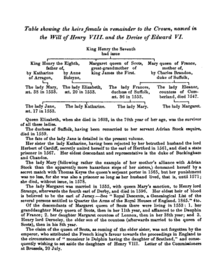Will of Henry VIII of England
The will of Henry VIII of England was a significant constitutional document, or set of contested documents created in the 1530s and 1540s, affecting English and Scottish politics for the rest of the 16th century. In conjunction with legislation passed by the English Parliament, it was supposed to have a regulative effect in deciding the succession to the three following monarchs of the House of Tudor, the three legitimate and illegitimate children (the Third Succession Act expressly recognised the illegitimacy of Henry's daughters) of King Henry VIII of England. Its actual legal and constitutional status was much debated; and arguably the succession to Elizabeth I of England did not respect Henry's wishes.
Last testament
Henry VIII made a final revision to his last will and testament on 30 December 1546. It was signed using the "dry stamp", a device in use since 1545 and under the control of Anthony Denny and John Gates. It confirmed the line of succession as Edward, Mary and Elizabeth; following them, the Grey and Suffolk families.[1][2] The will was read, stamped and sealed on 27 January 1547, when the dying king was past speech. He died within hours, the next day.[3]
The document still exists, but this fact was not generally known or accepted by the 1560s, when some believed it was lost, or had been destroyed.[4]
The 16 executors
The will appointed 16 executors. This body had little impact in the short term, because its powers were given to a smaller group. It was officially (with one other) the council of Edward VI of England until 12 March 1547, after which Protector Somerset nominated the council.[5] The effective end of the Somerset Protectorate came in early 1550. Those executors who were still alive (13 of the original 16, after Browne, Denny and then Wriothesley had died) had a leading constitutional role, in theory from 13 October 1549.[6]
The executors comprised:[7]
| Name | Position/profession | Religious orientation | Date of death |
|---|---|---|---|
| Thomas Bromley | Chief Justice of the King's Bench | (?, mostly absent) | 1555 |
| Sir Anthony Browne | Courtier | Catholic | 1548 |
| Thomas Cranmer | Archbishop of Canterbury | Reformer | 1556 |
| Sir Anthony Denny | Courtier | Reformer | 1549 |
| John Dudley, Viscount Lisle | Military leader | Reformer | 1553 |
| Sir William Herbert | Courtier | Reformer | 1570 |
| Sir Edward Montague | Chief Justice of the Common Pleas | (?, mostly absent) | 1557 |
| Sir Edward North | Lawyer | Neutral | 1564 |
| Sir William Paget | Politician | Neutral | 1563 |
| William Paulet, Baron St John of Basing | Politician | Neutral | 1572 |
| John Russell | Admiral | Reformer | 1555 |
| Edward Seymour, Earl of Hertford | Military leader | Reformer | 1552 |
| Cuthbert Tunstall | Bishop of Durham | Catholic | 1559 |
| Sir Edward Wotton | Administrator | ? Catholic | 1551 |
| Nicholas Wotton | Cleric and diplomat | ? Catholic | 1567 |
| Thomas Wriothesley | Administrator | Catholic | 1550 |
Pollard wrote that the traditional view, that the balance of the group of executors on the religious question was deliberately poised to create an equilibrium, is mistaken: the exclusion of Stephen Gardiner tipped the balance to the evangelical reformers.[7] MacCulloch considers that in 1550, after the fall of Somerset, there was a balance, but that the evangelicals manoeuvred to a position of superiority.[6]
Third Succession Act

The constitutional standing of Henry VIII's last will depended on the Third Succession Act that received the royal assent in 1544. Section VI of the act provides that the line of succession, if not continued by the king's children by his marriages, should be regulated by the contents of the king's last will. The wording is conditional on the will being signed by the king's hand.[8] The issue of the "dry stamp" signature was brought up in the context of Anglo-Scottish diplomacy, carried out by Robert Melville on behalf of Mary, Queen of Scots, in 1567. Since the provisions of the will disadvantaged all the claimants of the House of Stuart, the point remained important.[9]
Notes
- Ives, E. W. "Henry VIII". Oxford Dictionary of National Biography (online ed.). Oxford University Press. doi:10.1093/ref:odnb/12955. (Subscription or UK public library membership required.)
- Sil, Narasingha P. "Gates, Sir John". Oxford Dictionary of National Biography (online ed.). Oxford University Press. doi:10.1093/ref:odnb/10448. (Subscription or UK public library membership required.)
- David Starkey (2002). The Reign of Henry VIII: Personalities and Politics. Vintage. p. 143. ISBN 978-0-09-944510-4.
- Levine, p. 155.
- D. E. Hoak (1976). The King's Council in the Reign of Edward VI. Cambridge University Press. p. 259. ISBN 978-0-521-20866-6.
- Diarmaid MacCulloch (1996). Thomas Cranmer. Yale University Press. p. 447. ISBN 0 300 07448 4.
- Albert Frederick Pollard, England under Protector Somerset: an essay (1900), pp. 20–1; archive.org.
- Joseph Robson Tanner (1951). Tudor Constitutional Documents, 1485–1603. Cambridge University Press. pp. 398–9.
- John Guy (2005). Queen of Scots: The True Life of Mary Stuart. Houghton Mifflin Harcourt. pp. 267–8. ISBN 0-618-61917-8.
References
- Mortimer Levine (1966). The Early Elizabeth Succession Question 1558–1568. Stanford University Press.
- Alison Plowden (1985). Lady Jane Grey and the House of Suffolk. Sidgwick & Jackson. ISBN 0 283 99055 4.